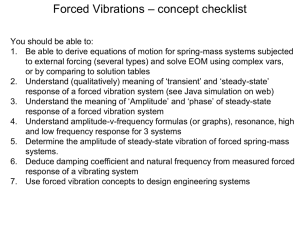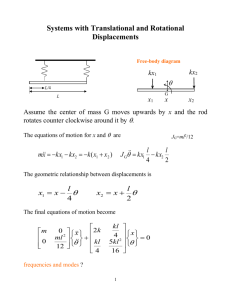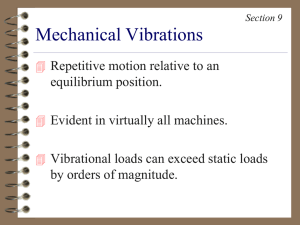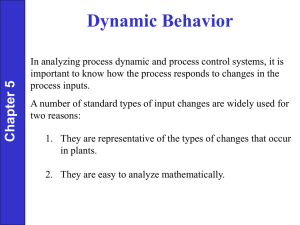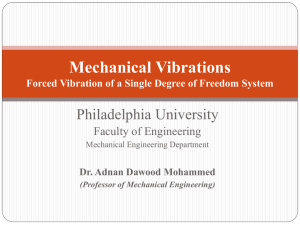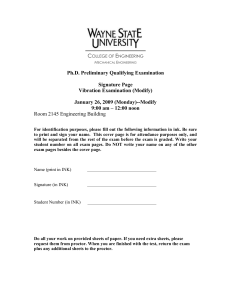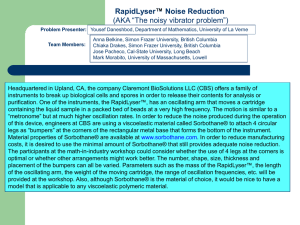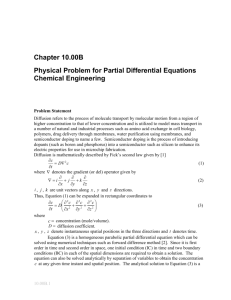Multi-degree of Freedom Systems
advertisement
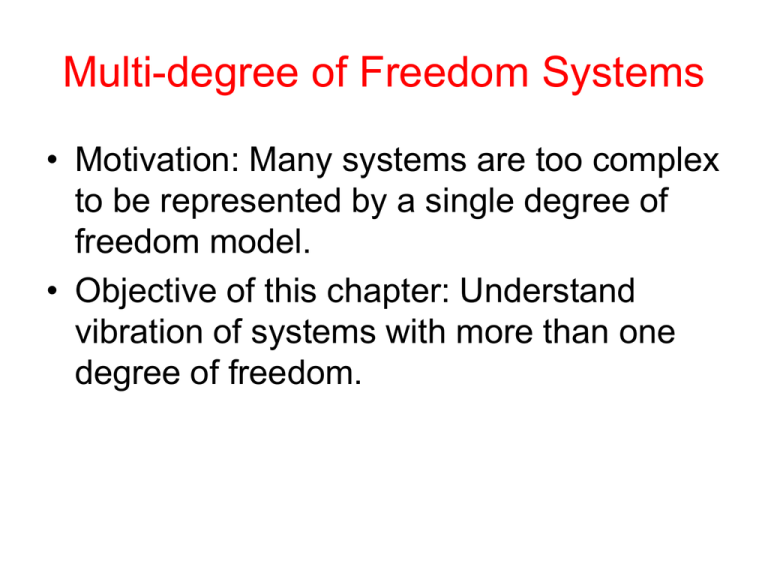
Multi-degree of Freedom Systems • Motivation: Many systems are too complex to be represented by a single degree of freedom model. • Objective of this chapter: Understand vibration of systems with more than one degree of freedom. Free-vibration of undamped twodegree of freedom system • We learn how to analyze free vibration by considering an example x1 x2 k3 k2 k1 m1 m2 Deriving equations of motion k1x1 k2(x1-x2) m1 k2(x2-x1) m2 k3x2 m1x1 ( k1 k2 ) x1 k2 x2 0 m2 x2 k2 x1 ( k2 k3 ) x2 0 Interpretation of coefficients First equation: k1+k2 is the force on m1 needed to move it slowly by one unit while m2 is held stationary. –k2 is the force on m1 need to hold it steady if m2 is displaced slowly by one unit. Second equation: k1+k2 is the force on m2 needed to move it slowly by one unit while m1 is held stationary. –k2 is the force on m2 need to hold is steady if m1 is displaced slowly by one unit. Maxwell reciprocity theorem: the force on m1 need to hold it steady if m2 is displaced slowly by one unit=force on m2 need to hold is steady if m1 is displaced slowly by one unit. Special case • Let m1=m2=m and k1=k2=k3=k. Then: mx1 2kx1 kx2 0 mx2 kx1 2kx2 0 Solution of equations of motion We know from experience that: x1(t ) A sin( t ) x2 (t ) B sin( t ) Substituting the above equation to eq. of motion, we obtain two eqs w.r.t. A, B : ( mA 2 2kA kB) sin t 0 ( mB 2 2kB kA) sin t 0 The above two equations are satisfied for every t mA 2 2kA kB 0 mB 2 2kB kA 0 Trivial solution A, B=0. In order to have a nontrivial solution: 2k m 2 det k 0 2 2k m k k 3k , m m First natural frequency: k AB m The displacement for the first natural frequency is: A A This vector is called mode shape. Constant cannot be determined. Usually assume first entry is 1. Therefore, mode shape is: 1 1 Thus, both masses move in phase and the have the same amplitudes. Second natural frequency: 3k A B m Mode shape for above frequency: A A Usually assume first entry is 1. Therefore, mode shape is: 1 1 The two masses move in opposite directions. Displacements of two masses are sums of displacements in the two modes: x1(t ) 1 1 k 3k t 1) c2 sin( t 2 ) c1 sin( x ( t ) 1 1 m m 2 General expression for vibration of the two-degree of freedom system x1(t ) A1 A2 c1 sin( 1t 1) c2 sin( 2t 2 ) x2 (t ) B1 B2 Observations: • System motion is superposition of two harmonic (sinusoidal) motions with frequencies 1 and 2. • Participation of each mode depends on initial conditions. • Four unknowns (c1, c2, 1, 2) can be found using four initial conditions. • Can find specific initial conditions so that only one mode is excited. How to solve a free vibration problem involving a two degree of freedom system 1) Write equations of motion for free vibration (no external force or moment) 2) Assume displacements are sinusoidal waves, and plug in equations of motion: Obtain equation: A 0 [C ( )] * B 0 where [C( )] [K ] 2[ M ] 3) Solve det[C(ω)]=0, obtain two natural frequencies, ω1, ω2. 4) Solve, A 0 [C(1)]* B 0 Assume A=1, and obtain first mode shape. Obtain second mode shape in a similar manner. Free vibration response is: x1(t ) A1 A2 c1 sin( 1t 1) c2 sin( 2t 2 ) x2 (t ) B1 B2 5) Find constants from initial conditions.


